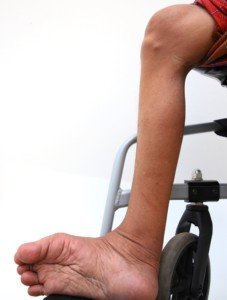Can a Gallbladder Polyp Turn Into Cancer?

There are different kinds of gallbladder polyps and this includes cancer.
So if it’s been discovered that you have a polyp in your gallbladder, should you panic and assume that it’s cancer?
Will the mass eventually transform into a malignancy?
There are no grounds for panicking or making this assumption, as there are several types of polyps associated with this organ.
A Polyp Was just Discovered in Your Gallbladder
“Gallbladder polyps are outgrowths of the gallbladder mucosal wall that are usually found incidentally on ultrasonography or after cholecystectomy,” says Akram Alashari, MD, a trauma surgeon at Geisinger Medical Center in PA, and author of “THE POWER OF PEAK STATE.”
Two Classes of Gallbladder Polyps
“They are classified as benign or malignant, and benign lesions are further classified as non-neoplastic (e.g., cholesterol and inflammatory polyps, adenomyomas) or neoplastic (e.g., adenomas, leiomyomas),” says Dr. Alashari.
Don’t be unnerved by the “oma” suffix here. “Oma” is the medical term for mass—but the mass can be benign.
“The most common benign neoplastic lesion is an adenoma, a glandular tumor composed of cells resembling biliary tract epithelium.
“It is unclear whether adenomatous polyps represent a premalignant lesion and if so, the frequency with which they progress to carcinoma.”
Cancer-related molecular changes that are seen in gallbladder cancers have not been identified in adenomas.
“Nevertheless, larger polyps are more likely to contain foci of invasive cancer, and some studies suggest a correlation between the presence of gallbladder polyps and the risk of gallbladder cancer.”
Symptoms of Gallbladder Cancer
- Abdominal pain, especially in the upper right region
- Abdominal bloating
- Fever
- Nausea
- Weight loss that is not intentional or explainable
- Yellowing of the whites of the eyes or the skin (jaundice)
Risk factors for this disease include aging, female gender and a history of gallstones.
However, the disease is still rare in people who’ve had gallstones.
Another risk factor is infection of this organ.
Gallbladder cancer is a rare condition. The occurrence in the U.S. is 12.3 per 100,000 men and 27.3 per 100,000 women.

Dr. Alashari was formerly with Grand Strand Regional Medical Center in SC as an abdominal and critical care surgeon.
 Lorra Garrick has been covering medical, fitness and cybersecurity topics for many years, having written thousands of articles for print magazines and websites, including as a ghostwriter. She’s also a former ACE-certified personal trainer.
Lorra Garrick has been covering medical, fitness and cybersecurity topics for many years, having written thousands of articles for print magazines and websites, including as a ghostwriter. She’s also a former ACE-certified personal trainer.
.
Top image: Shutterstock/Pressmaster
Lower Stomach Pain from Running Could Be Serious

The pain you experience in the lower abdomen from running is probably harmless, but you may also consider seeing a doctor about it.
“Lower left, or lower right for that matter, pain can be from something as typical as a muscle ‘stitch,’” says Marc I. Leavey, MD, a primary care physician with 40+ years of experience.
What is the runner’s stitch?
Dr. Leavey explains, “This is a muscle cramp of the abdominal muscles caused by vigorous exercise without good preparation.
“Dropping back to a slower rate, exercising the area, and being sure that you are in good condition and well-hydrated are mainstays of preventing this issue.”
Drink water before you go on your run, as this will help prevent the pain in the lower abdomen. Even if you’re not thirsty, drink that water.
Don’t wait till the cramp comes on to do it. If the lower stomach pain occurs while you’re running, slow to a walk and take out the water, warming down with the walk, then stop and drink up.
Other Possible Causes of Lower Stomach Pain when Running
“However, there are a plethora of issues that can arise apart from this which can cause very similar pains,” says Dr. Leavey.
“Abdominal or inguinal hernias, issues with the intestines or GI tract, and gynecologic problems can also cause pain with running, often indistinguishable from a simple stitch.
“So, if you are having pain, and it does not easily resolve, or if there are any questions at all, you really should see your physician to be sure that nothing serious is going on.”
Women should head first to their gynecologist, even though it may seem logical to head first to the gastroenterologist.
A serious problem with the ovaries could cause pain in the lower abdomen that may become more apparent when running.
A transvaginal ultrasound will give an OBGYN a good view of the ovaries.

Dr. Leavey was formerly with Mercy Medical Center in Baltimore, MD, where his focus was primary care and internal medicine. He has a blog, STRING OF MEDICAL PEARLS.
 Lorra Garrick has been covering medical, fitness and cybersecurity topics for many years, having written thousands of articles for print magazines and websites, including as a ghostwriter. She’s also a former ACE-certified personal trainer.
Lorra Garrick has been covering medical, fitness and cybersecurity topics for many years, having written thousands of articles for print magazines and websites, including as a ghostwriter. She’s also a former ACE-certified personal trainer.
Nausea, Puking from Lifting Weights: Advice from Doctor

Here’s what a doctor advises if you suffer from nausea and vomiting from a weightlifting workout.
“A major cause of nausea and vomiting with weightlifting is doing too much, too quickly, without adequate preparation,” begins Marc I. Leavey, MD, a primary care physician with 40+ years of experience.
“While you should be well-nourished and well-hydrated before vigorous exercise, you need time to digest the food, and let the majority of it leave the stomach.
“Otherwise, that adrenaline rush that you get when you start an exercise set will do just what it does at other times, shut down digestion, divert blood to the arms and legs, and empty out the GI tract.”
Look at it this way: The body is hardwired to summon up certain biochemical responses to a perceived danger.
When you begin a hardcore weightlifting session, the body can’t tell if this is an encounter with a wild boar or a safe training routine inside a building. So the body starts gearing up for a fight or flee response.
To prepare for the fight or escape from danger (a physiological response that came in very handy during caveman times), the body empties the GI tract—you puke.
But why? So that the body could rid as much baggage as possible to be as efficient as possible during the fight or escape from “danger.”
This is why sometimes, a person will upchuck or at least suffer nausea simply upon viewing a grisly scene, such as the aftermath of a motorcycle accident.
Think of the contents of your gut as the equivalent of carrying a weighted rucksack. The rucksack would be a hindrance if you had to fight or run from danger.
So the body should shed it. Likewise, you vomit when faced with what the body perceives as a threat.
And let’s face it—a grueling set of deadlifts and squats could fool the body into thinking it’s time to dump the baggage.

Shutterstock/tankist276
Dr. Leavey explains, “Better to have a healthy meal, give time to digest, and start the routine a bit slower to allow the body to acclimate.
“Clearly, as you get more into exercising, this should become less of a problem, but early on it can be a limiting factor.”
Maybe you’ve read that prior to lifting weights you should ingest a good heap of protein. Give a bit more time between doing this and starting your working sets.
Also, as Dr. Leavey says, pay more attention to the warm-up. Don’t just dive into your maximal loads.
To further help prevent vomiting during or after a weightlifting routine, eat something at the 45 minute mark (and this time lapse excludes warming up).
It should be a combination of protein and quick-acting carbohydrates.
Another factor in the barfing up or at least feeling nauseous during weight training is that of having an untrained body, in combination with lack of nourishment.
When I used to be a personal trainer at a gym, the only clients of mine who ever experienced nausea and a little upchucking were not well-trained, and a few of them had not eaten much in the preceding hours.

Dr. Leavey was formerly with Mercy Medical Center in Baltimore, MD, where his focus was primary care and internal medicine. He has a blog, STRING OF MEDICAL PEARLS.
 Lorra Garrick has been covering medical, fitness and cybersecurity topics for many years, having written thousands of articles for print magazines and websites, including as a ghostwriter. She’s also a former ACE-certified personal trainer.
Lorra Garrick has been covering medical, fitness and cybersecurity topics for many years, having written thousands of articles for print magazines and websites, including as a ghostwriter. She’s also a former ACE-certified personal trainer.
.
Top image: Shutterstock/iambasic_Studio
Benign Calf Dent or Muscle Atrophy: Your Last Article!

Here is your FINAL article on the calf dent that you think is a sign of ALS muscle atrophy.
Do calf dents have you terrified you have ALS because you think this is how muscle atrophy should look?
Finding this article means that you are most likely deep within the agony of ALS fear originating from twitching muscles and/or dents in your legs.
You’ve been spending an lot of time inspecting your legs, particularly calves, for muscle atrophy.
Muscle twitching aside, you have discovered dents in one of your calves, or maybe just one dent there, and are wondering why the other calf doesn’t have the same dent or groove.

Could this be a sign of muscle atrophy in the “odd” calf that has the dent?
“No, no, and no,” says Marc I. Leavey, MD, a primary care physician with 40+ years of experience.
Dr. Leavey continues, “The dents are the definition from the hypertrophied muscles.”
Hypertrophy means the opposite of atrophy: muscle enlargement. If you’re into physique development, you’ll want dents.
You’ll know that these are the result of developed or trained muscle in combination with low body fat in that area.
Have you ever seen a person who has atrophied legs for real?
This would be someone who’s been paralyzed for so long that their muscles have wasted away.
Ever see them in shorts? No dents. That’s because the muscles have become putty.

This atrophied leg is smooth and dent-free. Shutterstock/podsy

Muscle atrophy but no grooves. Shutterstock/Somchai photo
Dr. Leavey says, “Someone in a wheelchair with paralyzed legs has nice, smooth, albeit useless, legs.” Yes, “smooth.”
What’s really happening is that your mind is playing tricks on you, all because you probably googled muscle twitching.
Though muscle atrophy is the result of ALS, a dent in a calf is not a hallmark sign of muscle atrophy.
Let’s go more extreme about this: bodybuilding. “Bodybuilders build muscles, and those muscles produce the physique and definition that is sought,” says Dr. Leavey.
“If you tried to build a clay model of a lower leg, making each muscle the desired size and shape, you would see that there are grooves and separations between these well-developed muscles.
“It is that very desired result that produces the dents that are seen in such individuals.”
But what if you’re not a bodybuilder?
“Whether bodybuilder or not, we all have the same muscles, in the same places,” says Dr. Leavey.
“Some are just shapelier than others. That means that a well-developed calf muscle may show good definition in a non-bodybuilder, yielding the same dent as the more active individual.
“Perhaps walking on stiletto heels caused a particular muscle to hypertrophy.
“For the most part, such muscle definition yielding ‘dents’ is not pathological.
“If there are any doubts, or if a change develops acutely, though, you should seek medical attention.”
I used to be a certified personal trainer for a major health club chain.
So I know a lot about muscles and body composition.
If you’ve lost body fat recently, and especially if you’ve been exercising more, and you’ve been noticing the development of a dent or two in your calves…this is the result of the fat loss and exercise!
Less fat between your skin and muscles, and firmer, more trained muscles mean increased definition, a.k.a. dents!
Stop worrying! It’s not atrophy! It’s not muscle wasting – it’s muscle growth!
Here is how this whole frightening process develops:
Your lower leg muscle begins twitching. You google this. On the first page of search results are links to ALS information.
Panic ensues. The twitching “spreads.” You read about muscle weakness and atrophy. You begin examining your legs.
Invariably, you discover dents that you swear were never there before.
Your mind begins playing tricks on you. New dents appear overnight.
From a Fitness Expert:
Listen to me: Calf dents are normal. It’s called muscle definition.
If you don’t believe me, open a fitness or bodybuilding magazine and look at the legs. They are full of dents.
In fact, check out magazines on running or soccer. People with low body fat, and especially with toned muscles from running, athletics or weight exercises, will have lower leg dents.
Bodybuilders, physique and figure competitors strive for calf dents as well as grooves everywhere else.

How many dents or grooves can you count in this bodybuilder? Shutterstock/Jasminko Ibrakovic
In fact, their jargon for calf dents is striations, cuts and rips. I’ve had personal training clients who, upon discovering dents in their legs and arms, became ecstatic and pointed them out to me:
“Look! I never had this before!” IT’S MUSCLE DEFINITION.
And in your case, you just never noticed it before. Muscle definition fluctuates.
So even if you know you never had a calf dent before, this is no cause for alarm.
Because muscle definition is variable over time, due to fluctuating eating habits, fluctuating exercise habits, and other factors that affect body composition and appearance — including water retention.
If you want to know what muscle atrophy REALLY looks like, look at the legs of someone in a wheelchair.
If anything, their atrophied calves had NO dents! Atrophied muscle that has turned flaccid and limp is dentless, because it’s not firm enough to show definition.
Anxiety causes twitching to rapidly spread, and it causes you to discover things that have always been there. So re-read this article!

Dr. Leavey was formerly with Mercy Medical Center in Baltimore, MD, where his focus was primary care and internal medicine. He has a blog, STRING OF MEDICAL PEARLS.
 Lorra Garrick has been covering medical, fitness and cybersecurity topics for many years, having written thousands of articles for print magazines and websites, including as a ghostwriter. She’s also a former ACE-certified personal trainer.
Lorra Garrick has been covering medical, fitness and cybersecurity topics for many years, having written thousands of articles for print magazines and websites, including as a ghostwriter. She’s also a former ACE-certified personal trainer.
Top image: Shutterstock/Joaquin Corbalan P
A Woman’s Ribs Showing Doesn’t Mean She’s Too Thin!
Here is why you shouldn’t assume a woman is unhealthy or too skinny just because her ribs show.
Many women have ribs that show. Some are undernourished, weak and unhealthy, while others can deadlift 250 pounds, knock off pushups, have all the energy in the world and never feel sick.
As a fitness expert and former personal trainer, I’m going to give you my perspective, and then I’ll give you the perspective from an internal medicine doctor whom I interviewed for this article.
If you don’t believe that feats of strength and endurance don’t indicate one’s health status, then consider this:
Many women with visible ribs have excellent cholesterol profiles, a perfectly normal heart and digestive system, low blood pressure, normal blood work and have beautiful skin and strong nails.
A woman who truly is too thin will most often show ribs.
However, I’ve seen women, whom I considered underweight, who were not showing ribs.
They were underweight in that they lacked muscle mass and had weak, frail looking arms and legs, and a frail looking torso – but the ribs were not showing in these “skinny fat” women.
If I lift my arms, my ribs will show. If I’m lying on a bench at the gym with my arms upward, and especially up-and-back, boy, do my ribs show.
They also show prominently if I’m leaning against something with my hands, arms outstretched, or if my arms are above me as when I’m in the “up” position of a lat pull-down exercise, or in the hanging portion of pull-ups/chin-ups/hanging leg raises.
However, I’m a physique athlete and avid powerlifter, and even though my ribs are visible, I also have visible muscle mass.
Physique and other athletes with controlled eating habits have visible ribs.

Freepik.com/artusofronov

Shutterstock/DuxX
These kinds of athletes typically are very conscious about the quality of the foods they eat.
They normally avoid fast food and other kinds of junk food, eating these items only occasionally.
They snack on healthy foods like fruit, salads and nuts, rather than chips, ice cream, candy and cookies.
They limit white sugar; some avoid it altogether.
How can people say these women are not healthy just because their ribs show?

Shutterstock/vectorfusionart
“For the average woman, reducing body weight to the lower range of the ‘normal’ scale, say a BMI of 18, may well result in the collar bones and lower rib margins being visible,” says Marc I. Leavey, MD, a primary care physician with 40+ years of experience.
“With stretching or bending, an overall view of the rib cage, though not being able to walk down individual ribs, may be evident.
“Since it is subcutaneous body fat that defines a woman’s curves and masks such structural anatomy, one could conceive that a woman scant on fat, with muscle comprising a higher fraction of the BMI, would have visible ribs.
“This would be unique to the individual, though, and should not be held as an ultimate goal.”

So what if her ribs show. Look at her strong, trained legs! She is not underweight. Freepik.com/artursafronov

Dr. Leavey was formerly with Mercy Medical Center in Baltimore, MD, where his focus was primary care and internal medicine. He has a blog, STRING OF MEDICAL PEARLS.
 Lorra Garrick has been covering medical, fitness and cybersecurity topics for many years, having written thousands of articles for print magazines and websites, including as a ghostwriter. She’s also a former ACE-certified personal trainer.
Lorra Garrick has been covering medical, fitness and cybersecurity topics for many years, having written thousands of articles for print magazines and websites, including as a ghostwriter. She’s also a former ACE-certified personal trainer.
The Type of Woman an Abusive Man Is Afraid Of

Abusive men are choosy in that they won’t pick just any woman to get involved with.
What kind of woman would a controlling man, who has a high propensity for abusing a girlfriend or wife, never get involved with?
An abusive man wants to control. He won’t be drawn to a headstrong, take-charge, outspoken woman.
A controlling man wants a woman who will never leave him, not one who will fight him — fight, as in press assault charges after the first incidence of violence; pack up her bags and leave; file for divorce; or seek revenge in some way.
And yes, some women will fight back physically and be quite successful.
If the man wants a woman who’d never leave him, he’s going to be drawn to a woman who seems needy or indecisive.
Nor will this man be drawn to a woman who upgrades her voice to authoritative when a man angrily interrupts her, as opposed to backing down.

There are all sorts of tip-offs the potentially violent man looks for:
How a woman reacts when a man (or woman) cuts in front of her in a line
How a woman interacts with the crusty mechanic at the body shop
How a woman responds to shoddy restaurant service or someone cutting her off on the highway.
Do not be misled by Hollywood’s portrayal of wife-beating men, who are often brawny-looking and covered in tattoos.
I once lived near a very short chubby man who looked like a college chemistry professor, appearing like the type of geeky man whom a few teenage punks would harass at the bus stop and then beat up. This very man beat his wife.
“We teach people how to treat us,” says Mary Jo Fay, RN, MSN, author of When Your Perfect Partner Goes Perfectly Wrong.
Fay says, “Suppose you meet a nice man and are out on Date 3; you tell him something you did at the job that didn’t turn out too good.
“He says, ‘Gosh, that was stupid. Why did you do that?’ Your radar should be saying, ‘Nobody calls me names!’ You should then share with him that sentiment, setting strong boundaries.
“Then, you keep your radar up for a while to see if he learned how you expect to be treated or not.
“If he never pulls that kind of behavior out of his hat again, great! You’ve just taught him one tiny piece of your expectations of him.
“However, if you said nothing about the ‘stupid’ comments, rationalized to yourself that he was just tired — had had a bad day himself — or it was the liquor talking,” or that you really were stupid, “then you have just taught him it’s okay to call you stupid.
“And guess what: Odds are next time he’ll call you a stupid [fill in the blank], or some other new and improved version because you just taught him it’s okay to call you names!”
Predators quickly learn from “co-dependents” how frail their borders are.
“A woman with strong self-esteem will have picked her purse up by now, gotten up and said, ‘Nobody calls me names,’ and marched out,” says Fay, referring to Date 3.
“This would be way too much work for a predator to follow up on. However, predators also know how to be Prince Charming for as long as it takes to hook his prey. I can’t tell you how many men I know who switched from Jekyll to Hyde on their wedding night.”
Abusive men are not superheroes. Abusive men have weaknesses. They are wounded from a corrupt childhood, and the tough act is only that: an act.
A truly tough man doesn’t beat up on helpless women. This isn’t to say that a wife-beater has never gotten into fights with other men.
But these kind of men will retreat when faced with a challenging woman, the kind of women “who are assertive, who know what they want, who don’t particularly like him ordering for them,” at restaurants, “or telling them what the two of them will be doing, are women he would avoid,” says Tina B. Tessina, PhD, psychotherapist and author of The 10 Smartest Decisions a Woman Can Make Before 40.

Dr. Tessina explains, “He doesn’t go for women who don’t melt when he tells them they’re beautiful, who are slightly suspicious of his charm, and hold themselves back a little.
“Women who understand that ‘too good to be true’ probably is, and wait to see if he lives up to his promises, are not good bets for him.”
 Dr. Tessina appears frequently on radio, TV, video and podcasts, and has been in private practice for over 30 years.
Dr. Tessina appears frequently on radio, TV, video and podcasts, and has been in private practice for over 30 years.
 Mary Jo Fay is a speaker, author and consultant who specializes in relationships.
Mary Jo Fay is a speaker, author and consultant who specializes in relationships.
 Lorra Garrick has been covering medical, fitness and cybersecurity topics for many years, having written thousands of articles for print magazines and websites, including as a ghostwriter. She’s also a former ACE-certified personal trainer.
Lorra Garrick has been covering medical, fitness and cybersecurity topics for many years, having written thousands of articles for print magazines and websites, including as a ghostwriter. She’s also a former ACE-certified personal trainer.
.
Top image: Freepik.com pch.vector
Stop Forcing Your Children to Share with Each Other !

There are a number of self-serving reasons why parents force their children to share their toys, games, whatever, with their siblings or kids outside the family.
Is it more about the parent than the child when a parent angrily makes a child share a toy with another child?
The world is confusing enough for kids without parents forcing them to share, and then next minute, these same parents refuse to share their own belongings with their children!
An example would be punishing little Kaylee for trying on Mommy’s necklace—and we’re talking a cheap costume necklace, not a string of real pearls.
Forcing Kids to Share
I grew up with several siblings. Though my parents didn’t harp on sharing, when it was mandated, it resulted in resentment towards the sibling. Having to split that last Twinkie in two was just ridiculous.
It’s more about the parent than the child.
Forcing kids to share, either with siblings or children outside the family, becomes much more about the parent’s rules and anger (“I’ll spank you if you don’t share,” or, “He’s your brother and you better learn to share with him!”), than about cultivating a deep sense of satisfaction from the act of being communal.
When kids are forced to share, never assume they have no idea that the parents don’t practice what they preach.
How many parents, who make their children share, are generous in the workplace when a co-worker is in need?
I don’t mean lending someone $100, but be honest: How many of you have kept silent upon hearing a co-worker asking if anyone had gum or aspirin, when you had these items in your purse or work drawer?
How many of you pass the same homeless people every day without ever buying them a sandwich or bringing them fruit from home?
Too busy? How often have you told your young ones, “I’m busy now,” when they wanted your time?
You didn’t share your time with your children because you were more interested in that crossword puzzle, the latest celebrity news or reading the endless inane comments on the Facebook page of a junior high school classmate you barely knew.
No research confirms that forced sharing creates empathy and compassion.
If you’ve been forcing this on your kids, ask yourself what you’re aiming to accomplish.
Do you really believe this will create compassion?
My older sister makes her teen daughters share, yet those girls frequently insult each other.
As a teenager, I had to share a bicycle with her, even though my father had the money to buy a second bike.
My sister would deliberately hog the bike all day during the summer by riding it to her full-time job (even though our stay-at-home mother would have happily driven her there and picked her up), while I was left at home all day with no bike to ride about the neighborhood.
Does forced sharing produce generous adults?

Freepik.com, marymarkevich
We’ve all seen it: An adult trots ahead of someone in the store to beat that person to a checkout line, or zips across the gym to beat someone to a machine that they can see the other person is heading towards.
It’s fair to wonder if this “me first!” approach was generated by being forced to share, or…by never being made to share. It would be interesting to ask 1,000 “me first” adults which way they had it growing up.
The sharing issue is often more about the parents than the children! Right now, I bet you can think of at least several parents who make their kids share—for the sole purpose of impressing other adults, or at least to avoid “looking bad” to those other adults. I’ve actually witnessed this. I bet you have too.
Encouraging Sharing Isn’t the Same As Forcing It

Freepik.com, standret
“Persuading your child to share is usually a good thing,” says Tina B. Tessina, PhD, a licensed psychotherapist in Southern California who counsels individuals and couples, and is author of over a dozen books including “It Ends With You: Grow Up and Out of Dysfunction.”
She continues, “Forcing the issue is not. Children need to be socialized, to learn how to interact and cooperate with others.
“If you know how to share, to work and play together, in short to be friends, you’ll have a happier life, surrounded by healthier people, as you grow up.”
Dr. Tessina says that children don’t need to share everything. “Certain times and things can be reserved for private and family use, but children need to understand those boundaries as they grow up.
“Think in terms of dealing with a college roommate after leaving home. Your child, as a young adult, needs to know how to maintain boundaries and also cooperate and share.
“This begins as a toddler, when you teach your child to share one small toy for a brief time, and increases as the child grows up.
“A child who can’t share won’t have good friends. A child who shares too easily may be taken advantage of.”
If you’ve ever been guilty of getting furious over your child or teenager for not wanting to share something, ask yourself how you conduct the adult version of sharing.
One evening I noticed that the dumpster to my townhome complex was overflowing, and the neighboring one had plenty of room. I deposited an old chair inside it.
Next day, the chair was sitting on my lawn. Obviously, someone had witnessed me use “their” dumpster and felt like being a total shmuck. I wonder if this person scolds his or her child when that child doesn’t want to share.
 Dr. Tessina appears frequently on radio, TV, video and podcasts, and has been in private practice for over 30 years.
Dr. Tessina appears frequently on radio, TV, video and podcasts, and has been in private practice for over 30 years.
 Lorra Garrick has been covering medical, fitness and cybersecurity topics for many years, having written thousands of articles for print magazines and websites, including as a ghostwriter. She’s also a former ACE-certified personal trainer.
Lorra Garrick has been covering medical, fitness and cybersecurity topics for many years, having written thousands of articles for print magazines and websites, including as a ghostwriter. She’s also a former ACE-certified personal trainer.
.
Top image: Freepik.com
Shortness of Breath vs. Trouble Breathing

“Shortness of breath” and “difficulty” breathing are NOT one and the same.
I’m in perfect health and have shortness of breath all the time—after completing strenuous routines at the gym or running up hills outside.
However, despite all these shortness of breath episodes, I never have difficulty or trouble breathing.
Shortness of breath is not the same as trouble with breathing.
It’s crucial that you don’t indiscriminately toss these terms around when describing your symptoms to a doctor.
A person with an episode of vocal cord dysfunction will experience difficulty breathing.
They won’t necessarily be short of breath (depends on what they were doing when the VCD occurs. If they were not exerting themselves they won’t feel “short of breath”).
In VCD, the passageway through which air enters to get into the lungs becomes constricted, so the person has the sensation of struggling to inhale air.
“Trouble breathing would be a patient’s complaint, that of being aware of some kind of difficulty with the act of breathing,” says Marc I. Leavey, MD, a primary care physician with 40+ years of experience.
“It would be difficult to align that term with the nomenclature used by physicians and nurses. Shortness of breath describes the sensation of not being able to get enough air.
“There may or may not be pain associated with this; one could call it ‘air hunger.’ A medical term normally used is dyspnea, which means difficult breathing.
“While the causes of shortness of breath can range from pulmonary to cardiac, and even to some gastrointestinal conditions, the description used can blur the differences between the terms.”
If you’re merely “out of breath” after sprinting down the street after your dog, this doesn’t mean you’re struggling to inhale.
If anything, it’s proof of how well you can breathe —you’re rapidly taking huge breaths.
A person with a VCD or asthma episode will have actual trouble with breathing, though with asthma the trouble involves exhaling.
A person with certain heart conditions will feel the classic “shortness of breath” or that of being “winded” while performing activities that previously did not quickly tire them out.
There’s nothing necessarily wrong with their lungs or airways. It’s just that the body isn’t getting enough oxygen—due to a problem with the heart, such as inadequate pumping.
At least once in my life I had what seemed to have been a VCD episode. I didn’t feel short of breath or winded when it happened, but when it happened, I struggled to inhale, to breathe in air. It was like my airway was reduced to the diameter of a straw.
The first episode was apparently triggered by air pollution or particulates in the air as I walked in the middle of the night through an industrial section of town. The episode lasted about 30-40 seconds.
The second incident occurred many years later. I was in a building that had recently been renovated, and I could smell all the chemicals in the air.
Seemed that something in the air got caught in my throat and made me cough a few times. Then right after, I could barely inhale.
I would inhale as deeply as possible, but it felt as though my airway was as narrow as a straw. This episode lasted about 15-20 seconds.
Congestive heart failure classically causes “shortness of breath” while the patient is at rest. But this doesn’t mean the patient has trouble breathing.
Laryngopharyngeal reflux (LPR) often causes difficulty breathing (the airway is affected), but not shortness of breath.
These two terms truly do have different meanings, so be sure you understand the difference when talking to your doctor. For more about LPR, go here.

Dr. Leavey was formerly with Mercy Medical Center in Baltimore, MD, where his focus was primary care and internal medicine. He has a blog, STRING OF MEDICAL PEARLS.
 Lorra Garrick has been covering medical, fitness and cybersecurity topics for many years, having written thousands of articles for print magazines and websites, including as a ghostwriter. She’s also a former ACE-certified personal trainer.
Lorra Garrick has been covering medical, fitness and cybersecurity topics for many years, having written thousands of articles for print magazines and websites, including as a ghostwriter. She’s also a former ACE-certified personal trainer.
.
Top image: Shutterstock/ShotPrime Studio
Why Raising Children is NOT a Crapshoot: You Get MANY Cracks!

Actually, you get MANY cracks at raising your children and being a parent because the process takes years, not seconds.
“You get only one crack at it,” my mother has often said about raising kids. Nothing could be further from the truth.
The only thing you literally get only one crack at is an event that takes only seconds, such as a dive in a springboard diving competition.
Gee, even a figure skater, whose performance lasts only four minutes, gets more than one crack (which is why sometimes, a skater who falls still goes on to win the event!).
You get many cracks in a tennis match. You could miss many shots and still win. And a tennis match can be over sooner than it takes to help your child with her science fair project.
You do NOT get one crack at raising a child.
An example is a woman I read about in an advice column who had a sullen, withdrawn adolescent daughter. The mother was doing something wrong. She couldn’t figure out what, but was open to finding out.
So one day she decided that every time she was on the brink of criticizing the girl, she’d instead zip her lip, take deep breaths, count to 10 and simply say nothing. She did this for 30 days straight.
At the end of 30 days, the change in her daughter was remarkable. The girl was more outgoing, happier, and even a teacher who ran into the mother at the local supermarket commented how the girl had suddenly began flourishing.
The mother changed the course of history in only 30 DAYS.
You do NOT get only one crack at parenthood.
You get MANY cracks…many, many chances to change your tune, to take a detour, to try a new route, to stop doing the same things over and over that don’t work, to wake up and smell the coffee that maybe your ways are damaging your children, not benefiting them.

What you reap unfolds before your eyes in very slow motion, not the fast motion of a gymnast on the balance beam who teeters and falls off, blowing the entire routine.
“You do get only one chance to parent your child, in that the child will grow up and be beyond your influence,” says Tina B. Tessina, PhD, a licensed psychotherapist in Southern California who counsels individuals and couples, and is author of over a dozen books including “It Ends With You: Grow Up and Out of Dysfunction.”
But Dr. Tessina then points out, “However, within the years that you have that influence, there’s absolutely no need to be perfect. In fact, a child will learn more from seeing you admit and correct your parenting mistakes than he or she will from perfect parenting.
“Psychologists speak of the ‘good enough parent’ who is a parent who is not God-like and perfect, but a real human being who models a lot of good behavior, but also admits errors and corrects them.”
A man once wrote to an advice column to share his story. One day he was telling his three-year-old son to name anything in the world he’d like Daddy to do for him.
The boy said, “Daddy, I want you to stop hitting me.”
The father could have scolded the boy with, “Well you keep being such a bad little boy I HAVE to hit you!”
Imagine how damaged this boy would have turned out had Daddy stayed on this path.
But the man realized he was being offered a new crack at parenthood—very early on in the game, too.
He decided to stop hitting his son. He wrote to the advice column several years after this rude awakening to report that people in public would come over and compliment him on how well-behaved his son was.
A parent gets many opportunities (perhaps thousands over just 12 months alone) to take different cracks at parenthood.
Every time your child suggests something to you that relates to how you treat him or her…THAT is an opportunity.
I don’t mean letting your 13-year-old date a 17-year-old because she begged you to, but often, kids do ask for reasonable requests.
Let’s say this 13-year-old is always getting picked on by an older sister and arguing always ensues.
Their mother always jumps in and yells, “Stop this bickering! You two disgust me! I’m ashamed I ever had you!”
One day the 13-year-old asks her mother, “Next time Gina and I are going at it, can you not intervene and just let us work it out on our own as long as it doesn’t get physical?”
Right then and there, the mother has a choice: Stay on the same destructive, worthless path that has failed to work for several years, or…take a NEW crack at parenthood.
If she bites back at the girl and tells her she has no business telling her how to parent, this woman pretty much guarantees that the girls will be fighting with each other for decades.
When the mother is 60 (and daughters estranged from each other) she’ll be telling everyone, “You get only one crack at parenthood. It’s a crapshoot.”
This mother will never realize that she’d once had a golden opportunity to change the long-term outcome.
Dr. Tessina explains, “It’s very important to have a relationship with your child in which you take the lead and teach them what they need to know, but also are kind, understanding and caring.
“This is not always easy to accomplish, and many mistakes will happen along the way.

“However, if you own up to your less-than-perfect moments, and make amends, correcting the problems, you’ll be okay. Your child can still love and respect you if he or she knows you’re an imperfect, real, human being, too.”
Parents have endless chances to alter that trajectory. Every chance, every opportunity, is a new crack at parenthood.
BUT…as the child gets older…those new cracks will have declining effect.
A 16-year-old who’s been damaged by a non-empathetic, harsh parent is more hardwired with the fallout than is the nine-year-old sibling.
 Dr. Tessina appears frequently on radio, TV, video and podcasts, and has been in private practice for over 30 years.
Dr. Tessina appears frequently on radio, TV, video and podcasts, and has been in private practice for over 30 years.
 Lorra Garrick has been covering medical, fitness and cybersecurity topics for many years, having written thousands of articles for print magazines and websites, including as a ghostwriter. She’s also a former ACE-certified personal trainer.
Lorra Garrick has been covering medical, fitness and cybersecurity topics for many years, having written thousands of articles for print magazines and websites, including as a ghostwriter. She’s also a former ACE-certified personal trainer.
.
Top image: ©Lorra Garrick
Why Young Girls Shouldn’t Be Taught the Cinderella Story

Is it wise for little girls to grow up on Cinderella, a cowardly woman who makes NO effort to escape an abusive situation?
What kind of role model is THAT?
Cinderella is among the most favorite fairy tale characters, but certainly not because she shows any resilience, talents or empowerment.
So fragile is Cinderella’s state of mind, that her stepsisters and stepmother don’t even need to exhibit feats of strength or magic to scare her into submitting to the abuse.
All they need do is bark out orders, and Cinderella, dressed in rags, drops to her knees and scrubs the floor.
Why would mothers want to present Cinderella as a character to be endeared?
Young girls dress up as her for Halloween. When my kindergarten niece came home from a party wearing a floor-length, shiny puffy dress, my father said, “You look just like Cinderella.” (Good thing he didn’t say she thinks like her!)
Cinderella is unable to assert herself and stand up for what she believes in, but that doesn’t matter, as long as she eventually gets the prince and lives happily ever after, right?
There are various story versions, but the bottom line is that Cinderella never had to make much effort to win over the prince, and in every version, magical and supernatural forces play key roles in rescuing her from the abuse.
Wouldn’t it be wonderful if our perfect soulmate one day appeared, and the only way to get him was to fit our foot in a slipper?
It wouldn’t matter if we looked like a gargoyle, if we had little education, if we had few skills or drive…as long as our foot fit into a shoe!
But Cinderella, quite frankly, has zero backbone. She won’t stand up to the bullies.
Children in first grade have been known to stand up to bullies, and here we have a grown woman who won’t. Cinderella has no inner strength.
I’m not suggesting that the reason a woman gravitates towards abusive men, or even lacks initiative to get ahead in life, is because Granny read Cinderella to her or dressed her up for Halloween as Cinderella. Of course not.
Family dynamics trump any fairy tale. How a girl sees her mother being treated by Dad or boyfriends is a very powerful determinant in what kind of men she’s drawn to as an adult. How Dad and Mom treated her is another forceful variable.
“By itself, the Cinderella story is just a story, and won’t shape a girl’s psyche,” says Tina B. Tessina, PhD, a licensed psychotherapist in S. California who counsels individuals and couples, and author of “Money, Sex and Kids: Stop Fighting About the Three Things That Can Ruin Your Marriage.”
“However, if it’s coupled with a lot of helplessness, such as helpless-acting and self-deprecating female family members, more stories and activities focusing on being rescued from life’s responsibilities, it can take on an iconic status.”
It seemingly already has: Cinderella is among the most popular Halloween costumes, and there’ve been a number of movies based on this fairy tale.
Nevertheless, Dr. Tessina notes that this story, if one of many in a girl’s childhood, won’t pose any harm if the other stories have strong female characters.
So again, nobody is saying that reading Cinderella to your daughter will mess her up.
But gee, it’s the idea of it. Why not stick to stories with strong, take-charge women who are actually shakers and movers?
Cinderella is not a self-made woman.
What kept her from simply standing up to her female “abusers,” then packing up her scant belongings and getting out of there?
Dr. Tessina explains, “Cinderella was conceived when women did not have the opportunity to escape; to live without protection was probably deadly. Women were denied rights in society.
“By that reckoning, Cinderella is actually pretty plucky. She does try to sew her own gown and get things arranged so she can go to the ball, but her ugly stepsisters defeat her.”
The fairy tale dates back to the 17th century. In some versions she gets help from doves and her deceased mother’s spirit.
So how much she actually arranges things varies. It’s easy to argue that 300 years ago, women indeed had few options, but many women today think like Cinderella, despite having multitudes of options.
On the other hand, think of the pluckiness of modern-day abused teenagers who have no fear of running away from a corrupt home, not knowing when their next meal or hot shower is coming.
What does Cinderella teach young girls?
- That it’s okay to let mean people step all over you?
- That you’re not allowed to assert yourself and try to work your way out of an abusive situation?
- That if you have good looks, all you need do is just be patient and that silver platter will eventually be handed to you?
“Rather than pointing to Cinderella as a bad influence, it would be more beneficial to talk with a daughter about today’s options, and I think women’s history is important for young girls to know, too,” says Dr. Tessina.
“I also don’t think it’s detrimental to believe that help comes when we need it, as long as we also understand that we have to do our part.”
We need a modernized version of Cinderella, one where she actually fights back (without the help of doves or magic that turns a mouse into a BMW).
And though many women actually do meet their Prince Charming by happenstance, it would be nice to see Cinderella do a bit more to earn her prince than stick her foot in a slipper.


















































